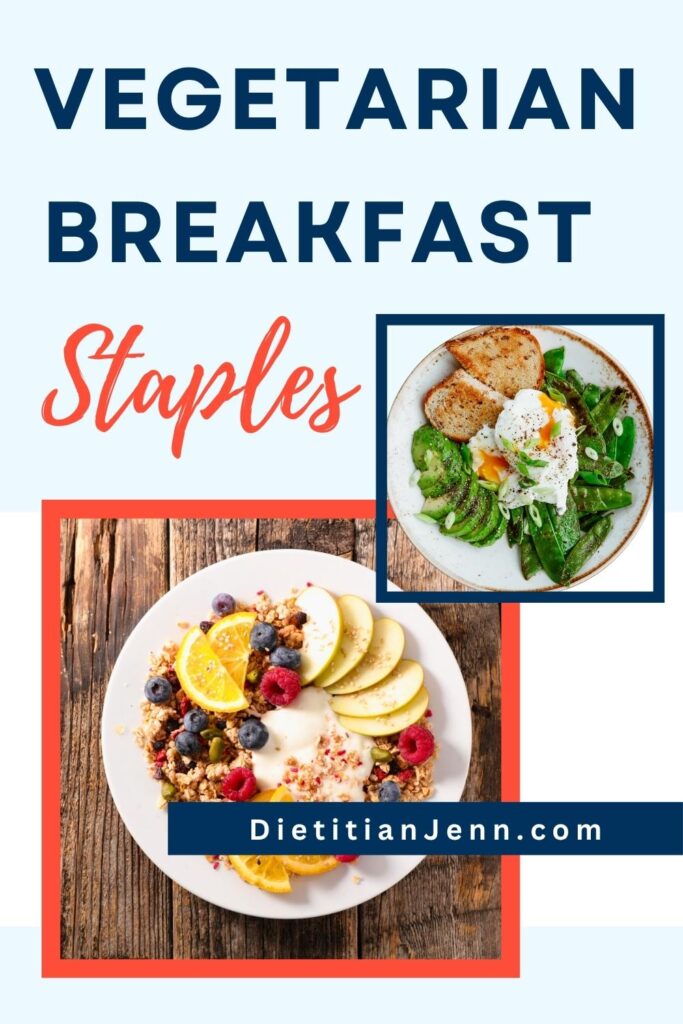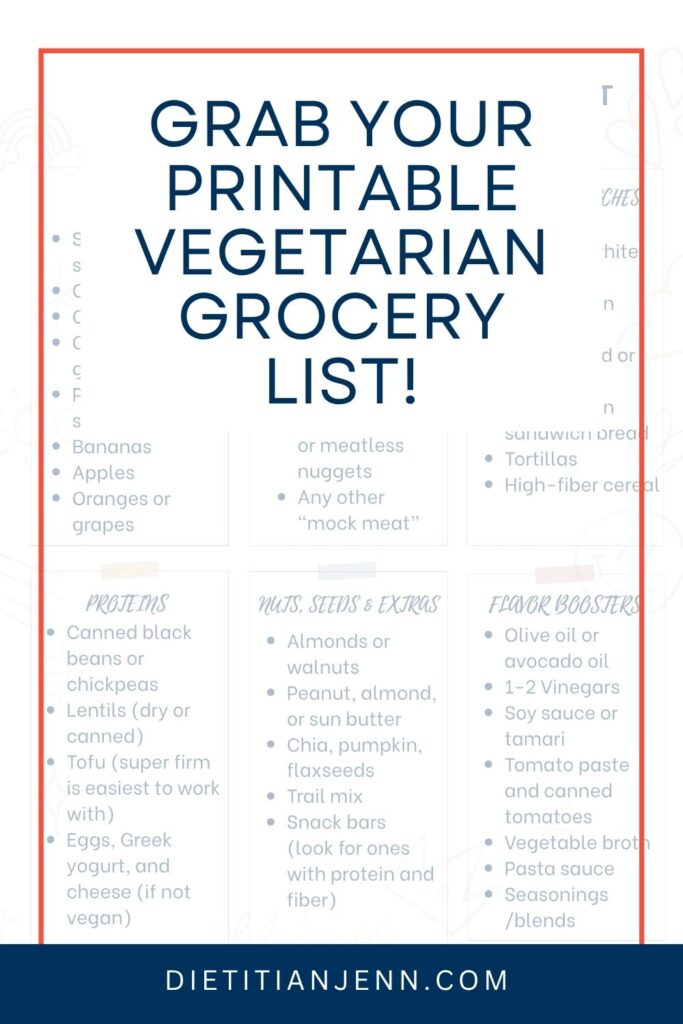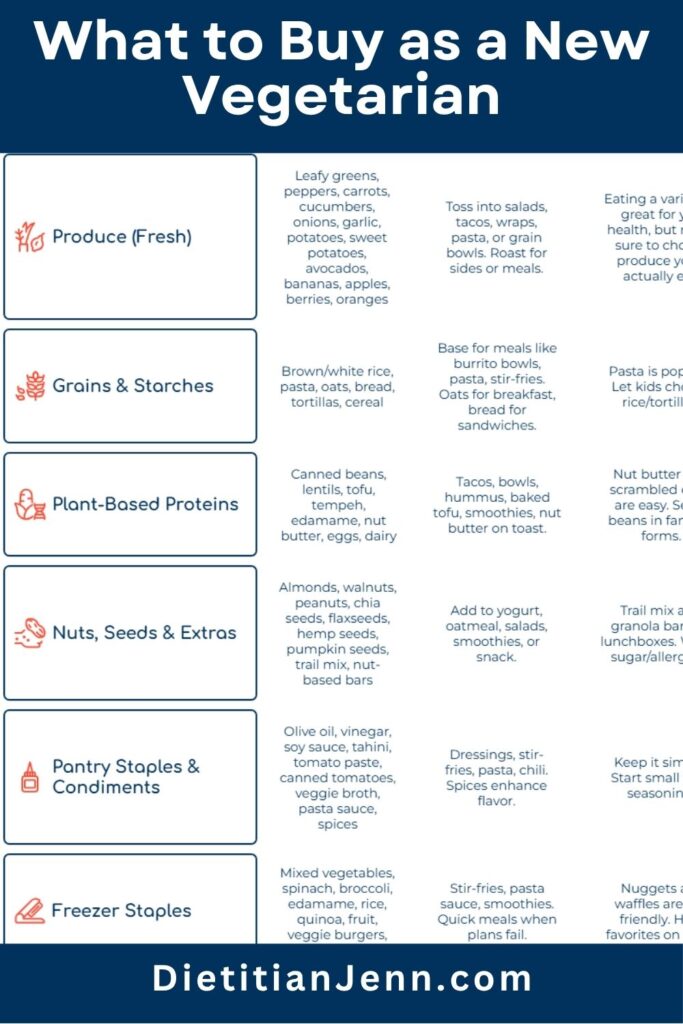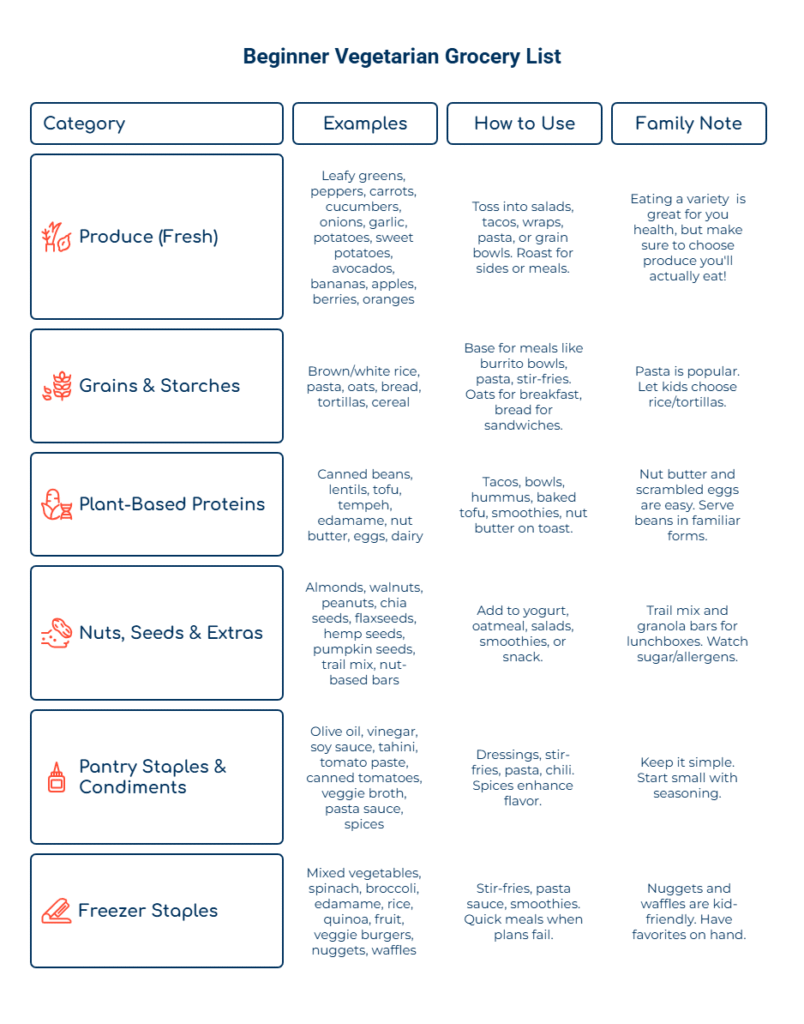Table of Contents
Ever find yourself standing in the grocery store, wondering what on earth to buy now that you’re trying to eat more vegetarian meals?
You’re not alone. When I first started helping clients shift toward a more plant-forward diet, one of the biggest sticking points wasn’t the meals, it was the grocery list. What do you buy when meat’s no longer the main event? Are tofu and kale your only options now? (Spoiler: definitely not.)
The good news? You don’t need to overhaul your whole pantry to get started. This beginner vegetarian grocery list is packed with practical staples that are easy to find, easy to use, and family-friendly, even if not everyone at your table is vegetarian.
Whether you’re going all in or just trying a few meatless meals each week, this guide will help you stock your kitchen without the guesswork.
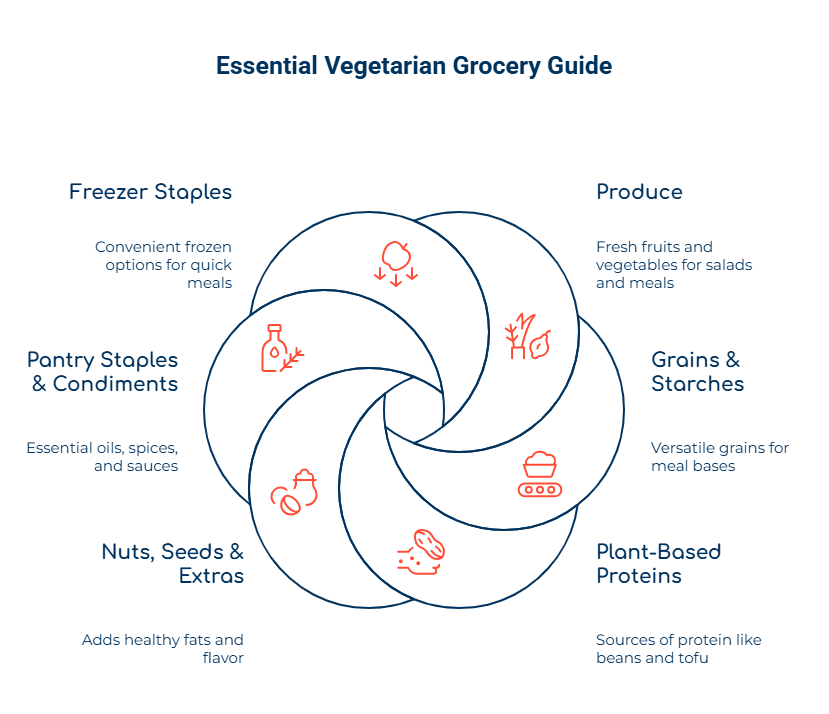
Grocery List Breakdown by Category
This beginner vegetarian grocery list is organized the way most grocery stores are. That way, it’s easier to shop and easier to plan what to do with what you buy.
You absolutely don’t need to buy everything on this list. Use it as a starting point. Pick the staples that work for your household and your budget, and build from there.
Produce (Fresh)
Fresh fruits and vegetables are the backbone of most vegetarian meals, but that doesn’t mean you need a cart full of fancy produce.
Grab these to start:
- Leafy greens (spinach, romaine, spring mix)
- Bell peppers, carrots, cucumbers
- Onions and garlic (for flavoring everything)
- Potatoes or sweet potatoes
- Avocados
- Bananas, apples, berries, oranges
How to use them:
Toss into salads, tacos, wraps, pasta, or grain bowls. Roasted veggies make great sides or can be the base of a full meal.
Grains & Starchy Staples
Grains provide staying power, and they’re endlessly versatile.
Beginner-friendly staples:
- Brown or white rice
- Pasta (regular or whole grain)
- Oats (rolled or quick)
- Whole grain bread or sandwich rolls
- Tortillas
- Cereal (look for ones with a little protein)
How to use them:
Build meals around a grain base. Think burrito bowls, pasta nights, or rice + veggie stir-fries. Oats make a filling breakfast, and whole grain bread is an easy vehicle for sandwiches or toast.
Family note:
Pasta is a hit in most homes. Just add sauce and a few veggies or beans. Letting kids choose between rice or tortillas can also give them some meal autonomy without extra work for you.
Plant-Based Proteins
This is often the trickiest category for beginners, but it doesn’t have to be. You have so many options, and not all of them require big changes.
Pantry and fridge-friendly proteins:
- Canned beans (black, chickpeas, kidney, cannellini)
- Lentils (canned or dry)
- Red lentils cook the fastest, fyi.
- Tofu (extra firm is easiest to start with)
- Tempeh (nutty, firmer than tofu)
- Edamame (frozen or fresh)
- Peanut butter or almond butter
- Eggs and dairy (if not vegan): cheese, Greek yogurt, milk
How to use them:
Make simple tacos or bowls with beans and grains, blend chickpeas into hummus, bake tofu, stir yogurt into smoothies, or spread nut butter on toast or fruit. You don’t need to get fancy, just start mixing and matching.
Family note:
Nut butter and scrambled eggs are easy wins with kids. You can also serve beans in familiar forms, like in tacos, chili, or pasta.
Nuts, Seeds & Extras
These add healthy fats, crunch, and flavor—plus a little protein boost.
Good starter options:
- Almonds, walnuts, peanuts
- Chia seeds, flaxseeds, hemp seeds
- Pumpkin seeds (pepitas)
- Trail mix
- Nut-based bars or granola
How to use them:
Add to yogurt, sprinkle on oatmeal or salads, blend into smoothies, or grab as a snack.
Family note:
Trail mix and granola bars can be lunchbox-friendly. Just keep an eye on added sugars or allergens if needed.
Pantry Staples & Condiments
This is where your meals go from “fine” to “actually good.”
Stock these to start:
- Olive oil or avocado oil
- Vinegar (balsamic, red wine, or apple cider)
- Soy sauce or tamari
- Tahini or nut butters
- Tomato paste and canned tomatoes
- Veggie broth (for soups, grains, sauces)
- Pasta sauce
- Spices: garlic powder, onion powder, chili powder, cumin, Italian seasoning, cinnamon
How to use them:
Use olive oil and vinegar for quick dressings, soy sauce for stir-fries, and canned tomatoes for pasta or chili. Even a few spices can make a huge difference in flavor without much effort.
Family note:
Keep it simple! A little seasoning goes a long way—if you’re new to using spices, start small and build confidence over time.
Freezer Staples
Frozen foods can be a huge help when you’re short on time or energy. They’re budget-friendly, nutritious, and easy to keep on hand for backup meals.
- Mixed vegetables (stir-fry blend, corn, peas, carrots)
- Frozen spinach or broccoli
- Edamame (shelled or in pods)
- Frozen brown rice or quinoa
- Fruit for smoothies or oatmeal
- Veggie burgers or meatless nuggets
- Frozen waffles or pancakes
- Optional: frozen vegetarian meals or pizza for emergencies
How to use them:
Microwave frozen rice and veggies for an instant stir-fry. Add frozen spinach to pasta sauce. Blend frozen fruit with yogurt or plant milk for smoothies. Veggie burgers or waffles are quick meals when dinner plans fall apart.
Family note:
Frozen nuggets and waffles are often hits with picky eaters. Keep a few “known favorite” options on hand to make busy nights smoother for everyone.
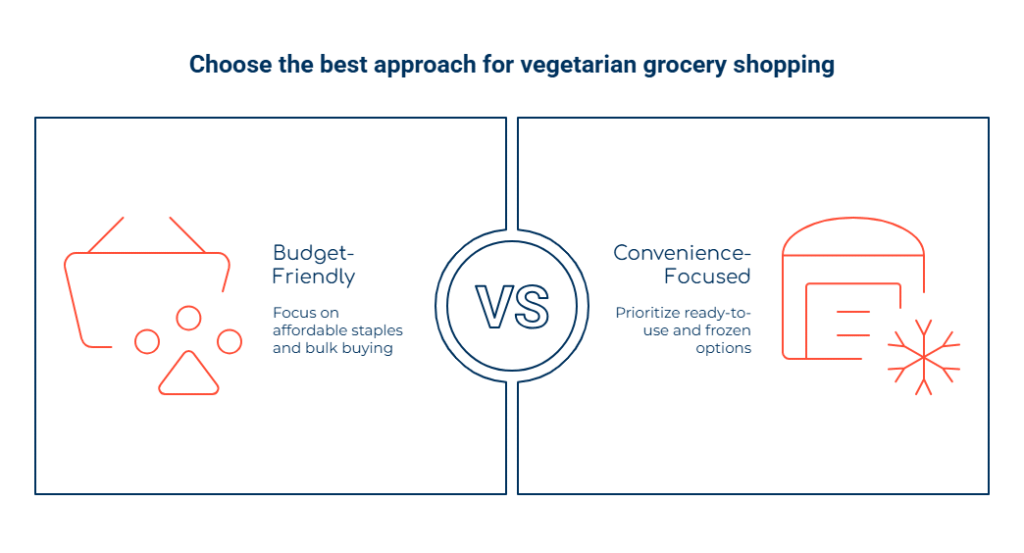
Beginner Vegetarian Grocery List (Printable Version Below)
Not sure where to begin?
This shopping list includes the basics I usually recommend to clients who are just starting to eat more vegetarian meals. You don’t need to buy everything here, just pick what works for your family, your meals, and your budget. The goal is to stock a few versatile ingredients that make it easier to throw together quick, satisfying meals.
Dietitian’s Tip:
Planning on cooking just a few vegetarian meals a week? Focus on buying a mix of fresh produce, canned beans, and a couple pantry staples to build around. You don’t need 50 ingredients to get started.
🥬Produce
- Spinach or spring mix
- Carrots
- Cucumbers
- Onions and garlic
- Potatoes or sweet potatoes
- Bananas
- Apples
- Oranges or grapes
❄️ Frozen
- Mixed vegetables (like stir-fry blend, corn, peas, carrots)
- Edamame (shelled or pods)
- Frozen fruit (for smoothies or oatmeal)
- Frozen brown rice or quinoa
- Veggie burgers or meatless nuggets
- Any other “mock meat“
🍞 Grains & Starches
- Brown or white rice
- Whole grain pasta
- Oats (rolled or quick)
- Whole grain sandwich bread
- Tortillas
- High-fiber cereal
🫘 Plant-Based Proteins
- Canned black beans or chickpeas
- Lentils (dry or canned)
- Tofu (super firm is easiest to work with)
- Eggs (if not vegan)
- Greek yogurt or cheese (if not vegan)
🥜 Nuts, Seeds & Extras
- Almonds, walnuts, or peanuts
- peanut, almond, or sun butter
- Chia seeds or flaxseeds
- Pumpkin seeds (pepitas)
- Trail mix
- Snack bars (look for ones with protein and fiber)
🧂 Pantry Staples & Condiments
- Olive oil or avocado oil
- Vinegar (apple cider, balsamic, or red wine)
- Soy sauce or tamari
- Tomato paste and canned tomatoes
- Vegetable broth
- Pasta sauce
- Garlic powder, onion powder, cumin, chili powder
- Italian seasoning or dried herbs
Beginner-Friendly Advice
“But What Do I Do With This Stuff?”
It’s one thing to have a grocery list. It’s another to get home, look at those ingredients, and feel completely stumped.
I’ve had that “now what?” moment more times than I can count. And it makes sense! If you’re used to building meals around meat, this new way of cooking can feel unfamiliar at first.
But, you don’t need to be a recipe expert or spend hours in the kitchen to make nourishing vegetarian meals. With just a few basic building blocks, you can mix and match ingredients from your list into meals that are simple, satisfying, and easy to repeat.
Here are a few of my go-to starter meals that use what’s already on your list:
🍲 Stir-Fry with Tofu and Frozen Veggies
Sauté extra-firm tofu in olive oil until golden, then toss in a bag of frozen stir-fry veggies. Splash in soy sauce or tamari, and serve over rice or noodles. Done in under 20 minutes.
Warm canned black beans (or frozen soy crumbles) with cumin and garlic powder. Spoon into tortillas with shredded lettuce, chopped tomato, avocado, and cheese or salsa. Great for build-your-own taco night.
🍝 Veggie Pasta
Cook pasta and stir in canned tomatoes or sauce and white beans or lentils. Add Italian seasoning and a little grated cheese (or skip it for a vegan version). When everything else is warmed through, add in a bunch of raw baby spinach and stir until it’s wilted. It’s cozy, simple, and endlessly flexible.
🥪 Chickpea Salad Sandwiches
Mash canned chickpeas with a fork and mix in a little mayo, mustard, and chopped celery or onion. Pile onto whole grain bread or stuff into a pita with lettuce. A nice twist on classic tuna or chicken salad.
🥣 Overnight Oats or Greek Yogurt Parfaits
For breakfast, combine oats, chia seeds, and milk of your choice in a jar for easy overnight oats. Or layer Greek yogurt with fruit and granola. Both options are quick, customizable, and totally no-cook.
💸 Budget Tips
Worried that eating vegetarian means spending more? I get it. Some of the trendier plant-based products can be pricey, and it’s easy to feel like you need a whole new pantry just to get started. And it’s a common misconception that it is expensive to eat healthy.
But a vegetarian grocery list can be incredibly budget-friendly. In fact, many plant-based staples, like beans, grains, and produce, are some of the most affordable foods in the store.
The biggest tip: while mock or faux meats are convenient, they are also typically expensive, sometimes even more so than real meat! They can be nice to help you learn to cook without meat, and for quick meals, but you’ll pay for the convenience.
Here are a few ways to keep your grocery bill in check:
🫘 Buy Beans in Bulk (or at Least in a Can)
Canned beans are still super affordable and convenient, especially when you’re just getting started. But if you want to save even more, dried beans are an excellent option. Just soak and cook them in batches to use throughout the week or freeze for later.
🧂 Use What You Already Have
Before you shop, check your pantry, fridge, and freezer. You probably already have a few staples like spices, pasta, rice, or canned goods. Use those as a starting point and fill in the gaps instead of starting from zero.
❄️ Frozen Produce = Big Savings
Frozen fruits and vegetables are just as nutritious as fresh, often more affordable, and they last way longer. No more throwing out wilted spinach or moldy berries. They’re ready when you are.
🧃 Skip the Fancy Stuff
You don’t need $10 vegan cheeses or plant-based bacon to eat vegetarian. Focus on the basics: beans, grains, veggies, eggs, dairy (if you eat it), and affordable plant proteins like tofu or lentils.
Eating more vegetarian meals doesn’t have to mean spending more money. Start with what’s familiar, build around budget-friendly basics, and add to your kitchen slowly over time.
Want a full post on how to eat vegetarian on a budget? That’s in the works too.
🤷 What If My Family Still Eats Meat?
Let’s be honest: eating more vegetarian meals is one thing. But doing it in a household where not everyone’s on board? That’s a whole different challenge.
If you’re the only vegetarian in a multivore family, you’re not alone. I hear from so many people in the same spot: trying to honor their values or health goals without becoming a short-order cook or starting a dinner-time standoff.
With a little flexibility, you can serve meals that work for everyone.
🍚 Build-Your-Own Meals Are a Lifesaver
Tacos, grain bowls, wraps, pasta, and salads are all super customizable. Set out a few components, like rice, beans, veggies, cheese, avocado, and let everyone build their own version. You get a full plant-based meal, and your family can add meat if they want to.
You can do this with tacos, pasta night, pizza, baked potatoes, and more.
🥗 Share the Sides
Make your vegetarian “side” (like veggie pasta or chickpea salad sandwiches). This can be your entire meal (as long as you have enough protein), and the meat-eaters can add meat to it, or they can treat it as a side and still have a meaty main dish.
🔄 Flip the Script
Some nights, the “main dish” might be meat-based, but you can still fill your plate with the sides: think roasted veggies, rice, beans, or salad. You don’t need to be perfect every meal to make meaningful changes overall.
The goal isn’t to win anyone over or convince your whole household to go vegetarian. It’s to make mealtime less stressful and more aligned with how you want to eat.
You’re not being difficult. You’re being intentional. And that’s something worth sticking with.
If this is a major issue in your household, check out my more extensive article on Integrating Vegetarians and Omnivores.
Grab Your Printable Grocery List
Final Thoughts
If you’ve made it this far, I hope you’re feeling a little more confident about what to put in your cart, and what to do with it once you get home.
This grocery list isn’t a rulebook. It’s a starting point. There’s no “perfect” way to eat vegetarian, and no one’s grading your meals. (And if they are, that’s their business) What matters is that you’re making choices that work for you, one meal (or snack) at a time.
So whether you’re swapping in one plant-based dinner this week or stocking your kitchen from scratch, that’s progress. And that counts.
I’d love to hear what staples you rely on. Especially if you’ve found something that works well for picky eaters or multivore families. Drop your go-to vegetarian grocery finds in the comments below!
FAQs
That’s okay! You don’t have to eat tofu to be a “good” vegetarian. It’s just one option out of many.
You can get plant-based protein from beans, lentils, nuts, seeds, eggs, dairy (if you include it), and even whole grains like quinoa.
If you’re open to trying it again later, it helps to take the time to learn to cook tofu well. Or order it at an Asian restaurant.
This is one of the most common concerns, but getting enough protein on a vegetarian diet is totally doable.
Beans, lentils, tofu, tempeh, edamame, Greek yogurt, nuts, seeds, and eggs all offer solid amounts of protein. If you’re including a source at most meals and snacks, you’re likely getting what you need. Without having to obsess over numbers.
I’ve got a full post on high-protein vegetarian snacks if you want some inspiration!
Nope.
While organic can be a personal or environmental preference, it’s not required to eat well, or eat vegetarian.
If you’re working with a budget, prioritize buying a variety of produce (organic or not), and focus on building balanced meals. Washing fruits and vegetables at home can help reduce residue if that’s something you’re concerned about.
Remember: eating more plants in general matters way more than whether those plants “earned” an organic sticker.
Absolutely.
In fact, I recommend it, especially when you’re just getting started or trying to keep things simple.
Canned beans, frozen veggies, jarred sauces, and precooked grains are major time-savers, and they’re often more budget-friendly than fresh, especially if you want something out-of-season.
Just look for low-sodium or no-salt-added versions when possible, and rinse canned beans to reduce sodium.
You’re not “cheating” by using shortcuts, you’re just making meals more manageable.
Nope! The grocery list is a guide, not a checklist you have to complete. (And who am I, to tell you what to do?)
Start with the staples you’ll actually use. If you know your family likes tacos, grab tortillas, canned beans, and toppings. If you’re big on breakfast, maybe oats and fruit make more sense than quinoa and tempeh.
Use the list to build your own version that fits your style, budget, and preferences.
Pick 2–3 vegetarian meals you want to try this week and build your grocery list around those. That way, you’re only buying what you’ll actually use.
You can also shop your kitchen first—see what’s already in your pantry or freezer and plan meals around those items before heading to the store. That alone can help cut down on waste and keep your grocery bill more manageable.
Jennifer Hanes MS, RDN, LD is a registered dietitian, mom, wife, and vegetarian in North Texas. She has dedicated Dietitian Jenn to be a source of information, ideas, and inspiration for people like her, vegetarians that live with people with different dietary beliefs and/or needs in a multivore household.






